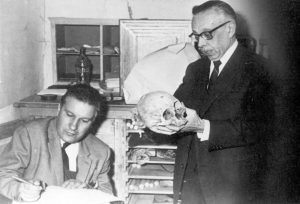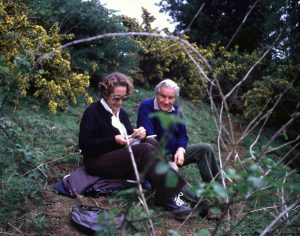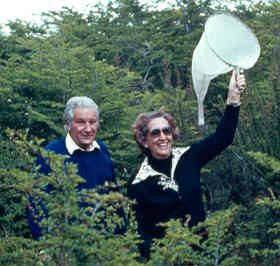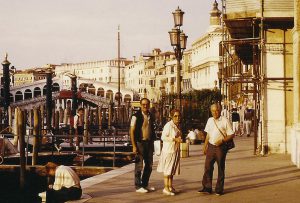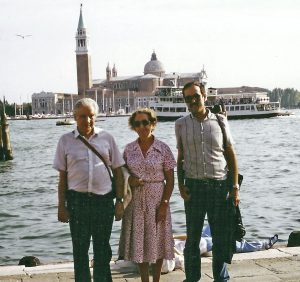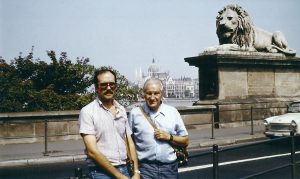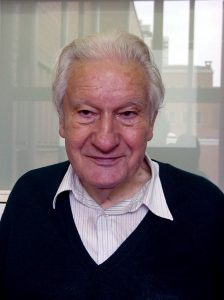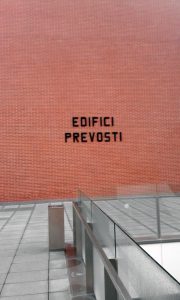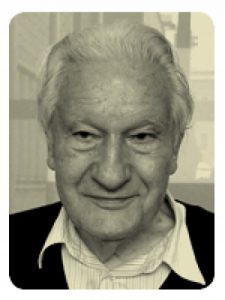
His long career as a researcher and teacher is made evident in all the geneticists he trained. He was a pioneer in genetic analysis of natural populations in Spain and a scholar of evolution.
Neither of these was an easy task. Born in Barcelona on 15 February 1919, he graduated with honors in Natural Sciences from the UB (obtaining the ‘Outstanding Student award' or Premi extraordinari) in 1942. So far so good. But as he himself explained, "My thesis director was Dr. Alcobé. He promoted genetics and taught me a course in Madrid. I told him I was interested in dedicating myself to it but, very politely, he told me was not a geneticist and did not think he could properly direct a thesis on this subject." That is how, accepting one of the proposals of Dr. Santiago Alcobé Noguer, professor of anthropology at the UB, he started studying the height of school-aged children, by comparing two different social classes. "I went to public schools to collect data and then to private schools", where he studied a sample of 723 girls and 726 boys of low income families and 751 upper class children. "There was an extraordinary difference. I remember that at age fourteen there was a fourteen centimeter difference in height between both classes," he explained. The thesis was entitled ‘Study of growth in schoolchildren of Barcelona' and was published in 1949 in the journal Trabajos del Instituto Bernardino de Sahagún (VIII, Anthropology) of the Spanish National Research Council (CSIC).
Alcobé's sincere refusal with regard to a thesis on genetics did not discourage him. Back in Barcelona, while doing his thesis, he had the opportunity to attend a course with professor Corrado Gini, on new approaches on statistics, and soon after receiving his PhD, he completed a 3-month research stay at the Institute of Statistics and Demographic Sciences of Rome with professor Gini to further his knowledge in this field. His Italian contacts led him to Ramon Margalef (who was carrying out research in Italy at the time) and he put him in contact with the researchers at the Hydrobiology Institute of Palanza, where during the summer of 1949 he completed a research stay under the direction of professor Adriano Buzzati-Traverso. With him he learnt the cultivation techniques for Drosophila (known generally as the common fruit fly, it is a very useful genus for genetic studies, since they possesses large chromosomes that can be easily studied), some basic aspects of genus taxonomy and, specially, staining and extraction techniques for the polytene chromosomes in the salivary glands of mature larvae, which were crucial in the evolutionary genetics studies he would do later on.
He put all this experience into practice at the Institute of Animal Genetics of the University of Edinburgh, where he spent two years-thanks to a grant from CSIC (1953) -studying the genetic effects of artificial selection in the length of the thorax and the wing of Drosophila melanogaster, studies which allowed him to deepen his knowledge of quantitative genetics.
His activity at CSIC had begun much earlier, in 1942. His started out as an intern in the ‘Bernardino de Sagahún' Institute of Ethnology and Anthropology (1942-1945); then as temporary collaborator at the same institute (1945-1951); later as a scientific collaborator in the Center of Animal and Human Genetics of Barcelona (1951-1956). From 1956 to 1963 he was scientific researcher by competitive examination at this center and during the period 1963-1968 he was supernumerary scientific researcher and later supernumerary research professor.
His teaching at the University of Barcelona was very intense. Immediately after graduating he taught practical courses of general biology and anthropology, from the 1943-1944 academic year to 1951 (1943: assistant professor of general biology; 1943-1947: assistant professor of general biology and anthropology; 1947: temporary adjunct professor of general biology and anthropology; 1947-1951: adjunct professor of general biology and anthropology). In 1955 he was appointed professor of genetics. This course had a special significance because it was the first time genetics was taught as a subject in Spain. He held this position until 1959 when he was appointed head of genetics, and in 1963 he obtained by competitive examination the chair of genetics. He taught general biology from 1963 to 1969, genetics from 1955 to 1986, evolution from 1962 to 1986, and three doctorate courses between 1986 and 1992 (cytogenetics and evolution, theories of evolution and sexuality, and genetic recombination and evolution).
He directed 23 PhD theses and 18 dissertations. In his research, his studies on the genetic basis of quantitative characters and the analysis of chromosomal inversion polymorphism in Drosophila suboscura, which allowed to demonstrate the adaptive nature of this polymorphism and analyze the speed and sometimes predictable nature of microevolutionary changes, stand out. He was the first director of the Spanish Society of Genetics (1973). In 1989 the Autonomous Government of Catalonia awarded him the Narcís Monturiol Medal for scientific and technological achievement; and in 1994 the City Council of Barcelona awarded him the city's medal for scientific merit, in the gold category.
Main works
- Ayala, F. J.; Serra, L.; Prevosti, A. (1989). «A grand experiment in evolution: The Drosophila subobscura colonization of the Americas». Genome, núm. 31, p. 246-255.
- Orengo, D. J.; Prevosti, A. (1996). «Temporal changes in chromosomal polymorphism of Drosophila subobscura». Evolution, núm. 50, p. 1346-1350.
- Prevosti, A. (1955). «Geographical variability in quantitative traits in populations of Drosophila subobscura». Cold Spring Harbor Symp. Quant. Biol., núm. 20, p. 294-298.
- Prevosti, A.; Ocaña, J.; Alonso, G. (1975). «Distances between populations of Drosophila subobscura based on chromosome arrangement frequencies».Theor. Appl. Genet., núm. 45, p. 231-241.
- Prevosti, A.; Ribó, G.; Serra, L.; Aguadé, M.; Balanyà, J.; Monclús, M. and Mestres, F. (1988). «Colonization of America by Drosophila subobscura: Experiment in natural populations that supports the adaptive role of chromosomal-inversion polymorphism». Proc. Natl. Acad. Sci. USA, núm. 85, p. 5597-5600.
More information
- Candela, M. (ed.) (2003). «Antonio Prevosti Pelegrín: pionero de la Genética de Poblaciones en España y estudioso de la evolución». A Los Orígenes de la Genética en España. Madrid, Sociedad Estatal de Conmemoraciones Culturales. ISBN: 84-95486-64-4.
- Diversos autors (1987). «Homenaje al Profesor Antonio Prevosti Pelegrín».Genética Ibérica, vol. 39, fasc. 3-4.
- Ruiz, H. (2005). «Entrevista a Antonio Prevosti i Pelegrín». Omnis Cellula, núm. 6, p. 36-43. [Consultable en línia <http://revistes.iec.cat/index.php/OC/article/viewFile/54408/54610>]
Image gallery
- Photo 1. Prevosti and Dr. Santiago Alcobé.
- Photo 2 and 3. Prevosti with his wife Maria Monclús, also scientist.
- Photo 4 and 5. Prevosti, his wife and Dr. Lluís Serra i Camó in Venice.
- Photo 6. Prevosti and Dr. Lluís Serra i Camó in Budapest.
- Photo 7. Portrait of Antoni Prevosti.

